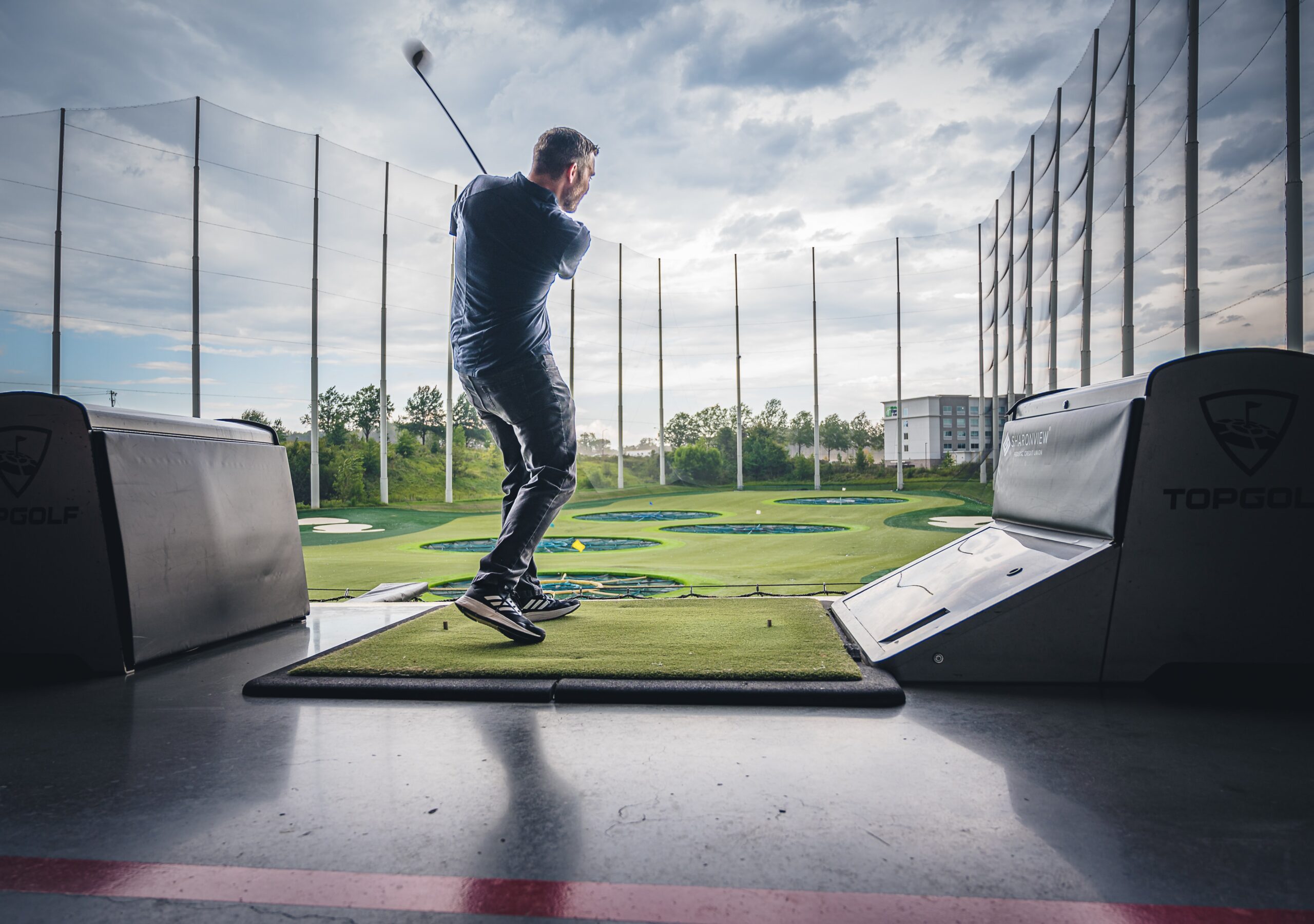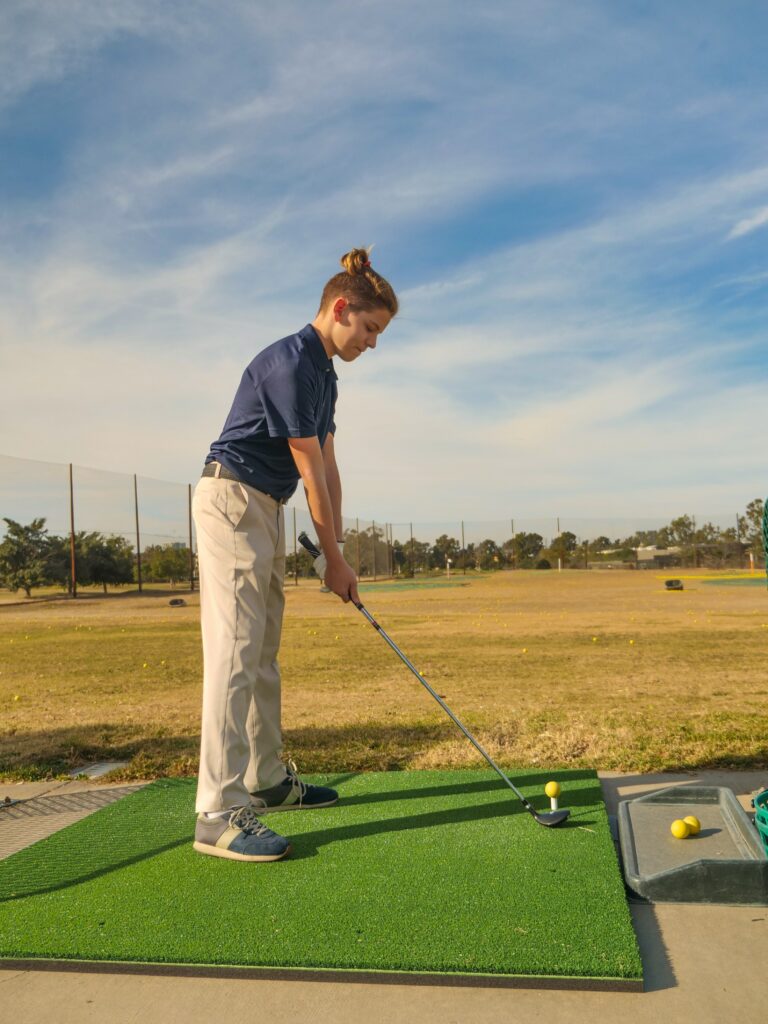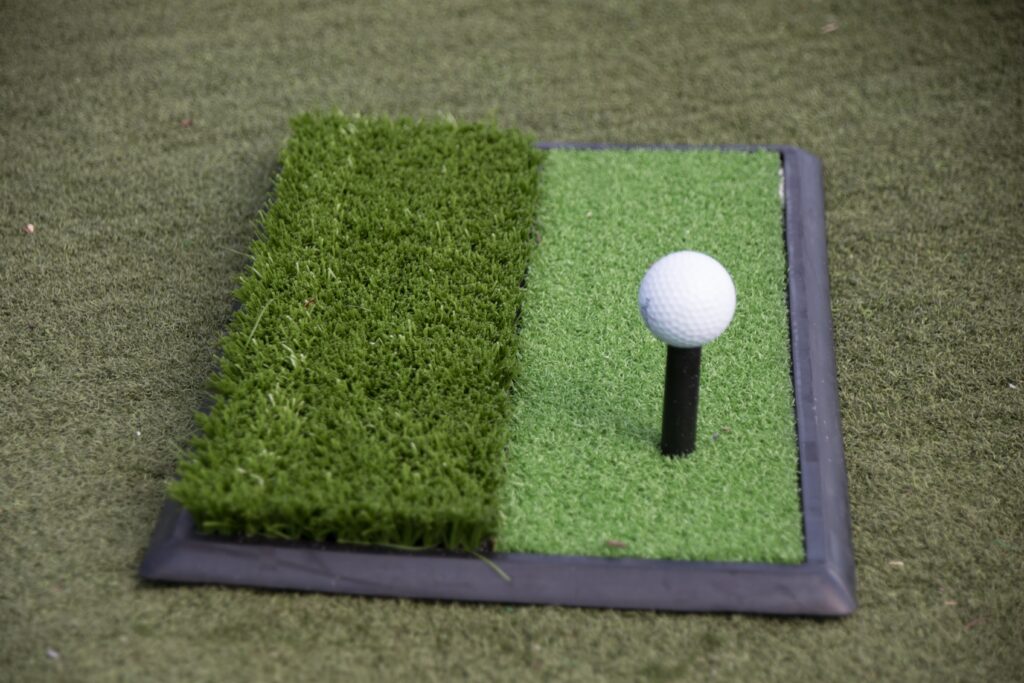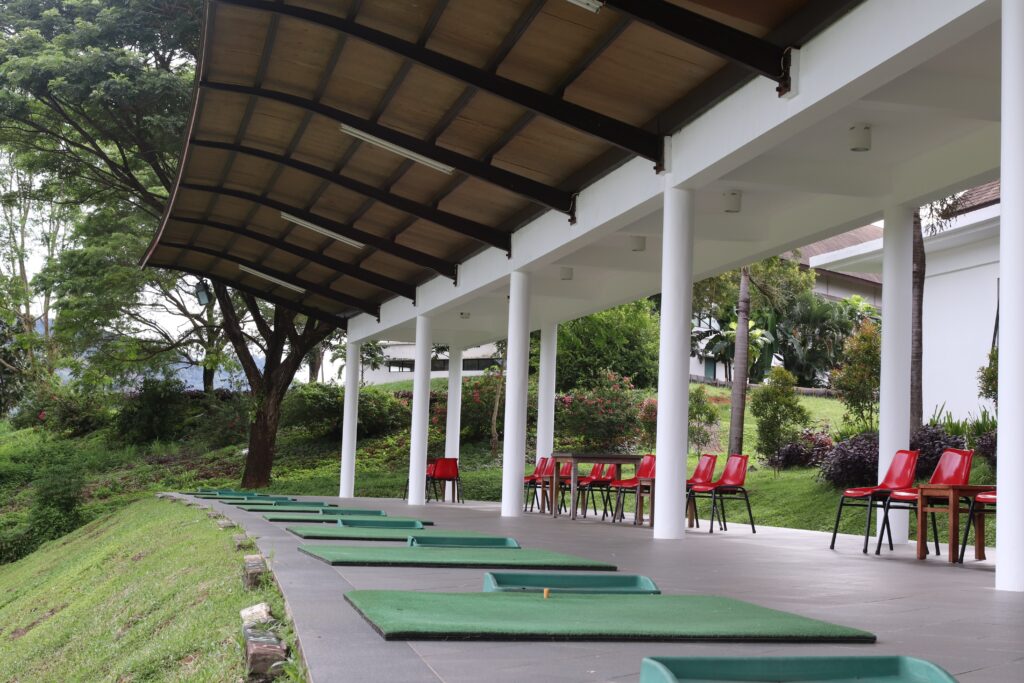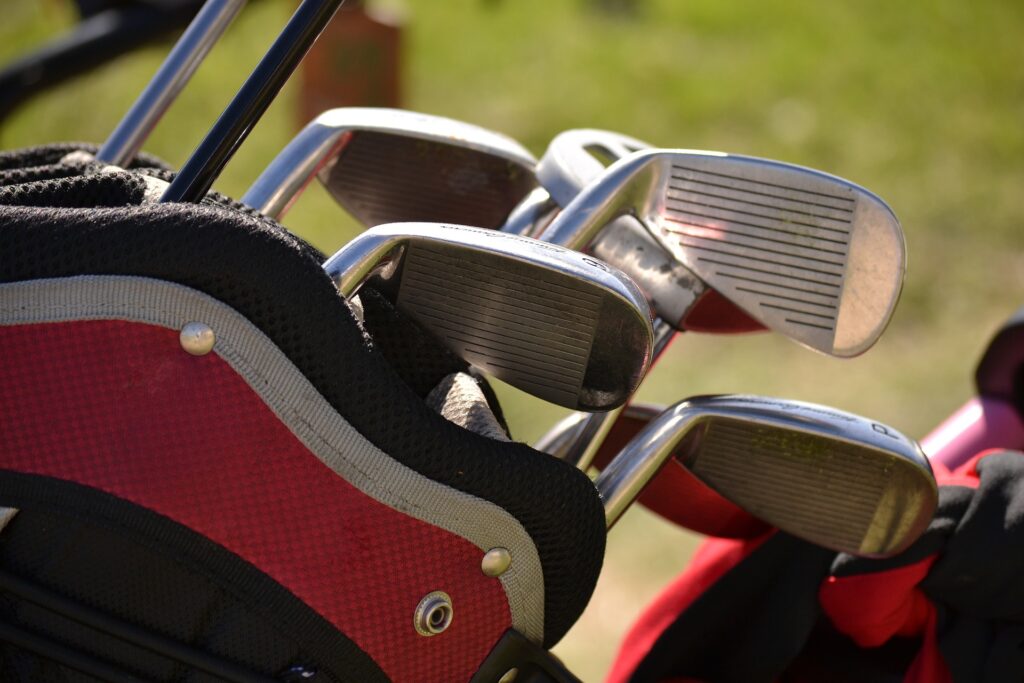In your own practice sessions, golf mats are undoubtedly a regular. Golf mats are much more common at the driving range these days. Since mat quality is improving, switching from turf to mat is a no-brainer. Additionally, turf tends to be more expensive to maintain.
A mat might play a significant role in your at-home training. Perhaps you have a complicated setup with a golf simulator. Or maybe you just want to keep your grass safe. Or perhaps you’d prefer to practice in your garage without damaging your body and equipment by hitting off the concrete.
A practice mat can be useful no matter what situation you’re dealing with. However, it can also harm your enjoyment, safety, and golfing skill.
Why Are Golf Mats Used?
If you consider the original purpose for which mats were created, you won’t be in error. The issue would not have arisen if players had access to grass areas on every practice field, right? Well, the bottom line is the price. Both the owners of the golf course and the driving range are attempting to increase their revenue while simultaneously accommodating as many players as they can. It requires money to get people to come. Additionally, maintaining actual grass can leave them with a sizable financial gap. If you ever get the chance to look through one of the golf courses’ bank statements, you’ll be amazed. To maintain the grass in a good, smooth, and closely mowed state for the players, they invest enormous sums of money. The price just doesn’t add up when it comes to practice areas or driving ranges. Driving range practice sessions would cost much more if there was actual grass there. The additional expense would be burdensome for the vast majority of players everywhere.
Mats vs. Grass
The mats can be compared to simulators. There are golf simulators, just as there are driving simulators.
Driving simulators allow you to operate the vehicle with realistic physics and add a variety of factors, both of which will improve your driving. Other elements, however, such as the asphalt grip coefficient, wind resistance, surface micro-bumpiness, suspension feedback, and so forth, simply cannot be taken into account. As a result, you’ll discover that the experience is very different from the simulator when you actually go out and drive. But if you use the simulator frequently enough, you’ll learn the fundamentals of driving and be better equipped to manage any unexpected scenarios. Golf mats are subject to the same law. On the mats and shot simulators, you can practice your game, but the real thing will always be different.
We will now examine some clear distinctions between matting and actual grass.
Divot
It all boils down to the fact that you can’t make a divot in a mat, which is the main difference between hitting off grass and a mat. Your club will interact with the hitting surface significantly differently since it will bounce off the surface rather than go through it. Comparing this to grass results in several advantages and a few downsides.
The Club Face and the Ball
Most golf mats available have smooth, grass-like surfaces. The premium ones, sometimes referred to as real-feel mats, are excellent for beginners. The shots, however, will feel different when you transition to the actual course. In most circumstances, it will be subtle, but you’ll definitely notice it. It’s only that genuine grass doesn’t react like synthetic grass. There will be debris, including grass blades, dirt, wetness, etc., between your face and the ball when you strike the ball from the fairway or the tee. Simply put, it’s impossible with golf mats. There won’t be much between the club face and the ball when you strike off the matting. The players receive clearer feedback as a result. Therefore, the golf mat you practice on might be one of the reasons your stellar driving range sessions don’t translate successfully on the course.
The Firmness
The stability of the surface you are standing on has a significant impact on how your club will perform. Real grass has a certain elasticity to it while being hard. Numerous premium mats have attempted to replicate the stiffness but have fallen short. Often, mats are more durable than actual grass. Additionally, they get harder over time. As a result, you are never able to make the divot on a mat that you could have made at the course. Additionally, there is a good probability that over time, the hardness of the mats will harm your clubs. The club head and shaft will be subjected to additional stress as a result of the hard surface’s feedback. It will significantly shorten the lifespan of your priceless wedges or irons!
In the end, a well-hit shot is a well-hit one, and there shouldn’t be much of a distinction between the typical mat and a fairway. Mishits will highlight the primary distinctions between mats and grass. The type of mat you are on will also affect how severe the drawbacks mentioned above are. Unfortunately, many driving ranges still make use of outdated, worn-out matting. The drawbacks will be highlighted by these mats. However, a lot of the new golf mats feature fantastic technology that virtually eliminates the distinction between mats and grass.
Advantages of Hitting from Mats
Develop Golfing Muscles
The muscle memory that develops from repeated swings is the primary factor in consistent ball striking. Hitting from mats can be an excellent approach to improve and maintain your golfing muscles as long as you are aware that the ball flight you are witnessing may not be an exact reproduction of what you will achieve on the course.
Improve Driving
The issue of unreliable feedback is mostly limited to using irons. This type of practice may be quite helpful because hitting your driver off the high rubber tees that typically come with mats demands essentially the same set up to the ball and swing path that you will use when teeing off on the course. In fact, there is a strong case for focusing the majority of your range time on perfecting tee shots given that the driver, along with the wedge and putter, is one of the three most crucial clubs in your bag. The space to hit full-blooded drives is another benefit of matted driving ranges over many other course practice facilities.
Useful Feedback from Mats
A good contact feels like a good contact regardless of the potential issue with fat shots, and a slightly fat strike from a mat won’t feel exactly like a genuinely struck shot even though it may fly higher than the same shot from grass. Laying a towel or piece of fabric just behind the ball will also solve the issue because it will make it clear if you hit the ball fat. When practicing on grass, this can also be a helpful additional visual signal, though obviously you shouldn’t do it on the course. Fat shots are just one type of mishit, despite how crucial it is to avoid them. When you are hitting from a mat, you can still instantly determine if you are inclined to top, push, pull, slice, or hook the ball.
Hitting From a True Surface
Even at facilities where it is theoretically possible, it can be all too unusual to have the opportunity to hit from uncut grass, as great as it is. At heavily used, well-known courses, finding grass to hit from can quickly become next to impossible due to the level of use. The sensation of frustration that resulted from trying to balance your ball on the narrow strips of turf left between the divots is not conducive to effective practice. The range staff will transfer the designated hitting areas to new turf when practical, but as the season goes on, they will constantly be fighting a losing battle.
Wet Weather and Winter Practice
The management will be compelled to lay down mats after a wet spell if they don’t want to risk permanent harm to the grass. Even still, the mats don’t harm the soggy grass as much as the striking does. Numerous practice greens include roofs, giving the grass and golfers some degree of weather protection. Some ranges are heated to make this a little more bearable in northern latitudes, where mats may be the only practical choice for any practice at all in the fall and winter.
Advanced Mat Technology
Companies now produce mats which they claim to be light years ahead of the cheap variety which were once the norm at ranges. These cutting-edge mats make use of gel and synthetic grass to simulate the experience of hitting on grass. Balls hit fat will behave just like those hit fat from grass, while the strain of impact on joints, muscles and tendons is significantly reduced. Some will also take a real tee, allowing you to vary the height at which you tee the ball, as you would on the course.
Disadvantages of Hitting from Mats
Mats Increase Risk to Injury
It takes a lot of physical effort to hit a significant number of golf balls one after another, and most golfers don’t know how harsh the shock of impact with the ball is on their hands, wrists, and shoulders. When you hit off of hard ground, the impact is much more intense, but it gets much harsher when you hit off of the thin mats put out on concrete beds that are frequently used at driving ranges.
If you’re one of the lucky few golfers who naturally approach the impact area at a shallow angle and can merely nip the ball cleanly off the surface, it might not be that awful. However, if you’re one of those who tends to hit the ball hard down and through, the massive hits that ensue can only cause sore muscles at best and catastrophic injuries at worst.
Tendonitis in the palms, wrists, elbows, and shoulders is a typical side effect, and golfers with pre-existing injuries like shoulder rotator cuff issues may endure excruciating agony after striking from mats.
Misleading Information About Swing
If practice is to be effective, it must offer precise feedback on how well you strike the ball. It does not do this, which is one of the most frequent arguments against striking off mats.
The unexpected solution may be that you were striking the ball much farther when practicing on mats if you’ve ever questioned during a round why you don’t appear to be getting the distance you expect from your irons.
“Fat” Shot Problems
In order to achieve adequate compression of the ball, the proper flight, and the proper distance for an iron, the clubhead must travel a slightly descended route into impact, striking the ball just before it cuts into the ground and creates a divot. Even if the inaccuracy is very little, “chunked” or “fat” shots”—which occur when the clubhead strikes the ground before the ball—are quite noticeable when struck from grass. But when a fat shot is hit from a mat the clubhead may bounce into the ball and produce a misleadingly good ball flight. Since there doesn’t seem to be any consequence for hitting a fat shot, repeated exposure to these errors may make them more common on the course.
Clubs’ “Lie Angle” Problem
The angle between the club shaft and the ground while the sole of the club is laying flat is known as the “lie angle,” which is a crucial but little-understood component of club specification. The clubhead will typically strike the ground heel first if the angle is too upright for the golfer’s height and swing, which will result in a pulled shot. On the other hand, a lie that is excessively flat will cause a push since the club’s toe will contact the ground first. These effects are amplified when playing on grass, and the pattern of the divots made makes them simple to identify. But as with fat shots, the bounce of the mats will tend to disguise any mishits, and of course there are not divots to be inspected.
Groove Poor Swing Habits
The subconscious mind is amazingly skilled at changing the body’s actions to minimize pain, and it won’t waste any time altering your golf swing to safeguard your joints and muscles from the strain of frequent contact with the mat. This indicates that your approach angle to the ball will probably become shallow with time. When using fairway woods and long irons, this is probably not a problem, but when using shorter irons, it is definitely a drawback. The achievement of the proper high flight with lots of backspin to guarantee that the ball stops quickly on landing is crucial for accuracy while using these scoring clubs. Only a firm downward strike, which mats discourage, will do this. And despite what might seem counterintuitive, a shallow clubhead path into impact increases rather than decreases the likelihood of a fat shot.
Damage Clubs
After a session of mat practice, the black or green marks that are frequently left on the soles of clubs are typically nothing more than a cosmetic inconvenience. The potential harm to your clubs from frequent, forceful contacts with concrete-backed matting is much more significant. It’s possible for expensively personalized forged irons to have their lie angles changed, and it’s also not rare to have club heads start to detach from shafts. Occasionally, clubs will even completely break. Using old clubs or purchasing second hand ones specifically for the range may allow you to get around the issue, but this is not the best course of action. One of the main goals of training is to become so comfortable with your clubs that they feel like an extension of your arms. Golf is essentially a game of feel.
Which Clubs To Use on a Hitting Mat
Iron shots off of a striking mat could be challenging depending on how much bounce is in the sole of your clubs. Additionally, how you swing the club and the type of golfer you are will affect this.
Since chipping is so reliant on feel and turf interaction, practicing wedges with a hitting pad will have the least practical application. Larger sole plates and high bounce wedges won’t perform well on rubber mats, while low bounce wedges will typically slip straight under the ball.
Utilizing them sparingly is one of the best pieces of advice for striking off of a golf mat. Too much swing practice on synthetic hitting mats will change the motion and feel of the swing. Due to the various striking surfaces, golfers frequently “scoop” the ball instead of “trapping” it as it hits the ground.
While a few sessions of practice on rubber hitting mats won’t completely alter your swing, continuous repetition over an extended period of time will alter the golfer’s natural impact angle of attack and swing path.
Conclusion
There’s no denying that golf mats have aided countless players in their efforts to learn the game. Instead of pondering whether or not hitting off golf mats will harm your game, you should learn how a mat differs from actual turf.
The most crucial thing is awareness. Mats have benefits and drawbacks, much like many other golf-related aspects. It’s your responsibility to educate yourself about them and adjust your gameplay accordingly.
